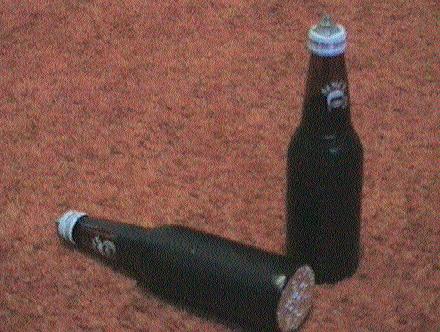
I have made a couple different sets of these before. My first bottle capacitors used Busch beer bottles. My newest set uses Hires root beer bottles. These are the best bottles I have found so far. They have more surface area on the cylindrical part, and have much longer necks. The contents of the bottles isn't bad either if you like root beer.
Lots of people make their bottle capacitors using a dishpan filled with saltwater in which the bottles are placed and they also have the bottles themselves filled with saltwater. The water in the dishpan would make up one plate and the other plate would be the saltwater in the bottles. The glass bottles are the dielectric. This is alright, but try to move them! Also, the salt will creep up the necks of the bottles causing arc-over. I have come up with a very simple, better, and less costly way of doing this. You don't need the dishpan for this.
Start by removing the labels and covering the cylindrical and the bottom portion of the bottles with aluminum foil. I use rubber cement to secure the foil to the bottles. Next you need to mix up some saltwater. Use a lot of salt as this will increase it's conductivity. Iodized or uniodized salts are fine. A couple tablespoons or so a bottle is normally plenty unless your bottle is huge. Fill the bottles with the saltwater until it is even with the top of the foil. After that, pour some vegetable oil in just to cover the top of the saltwater. This will supress corona. Next, take a screw on cap and drill a hole in the center. Then mount a bolt (1/4" x 6-7") onto the cap. Insert the bolt into the bottle's neck and screw the cap on. That's about it, it's almost done. To supress corona and to prevent damage to the foil wrap the cylindrical part in electrical tape. If really want to make a good capacitor the entire assembly (up to the neck) can be dipped in hot paraffin and allow it to dry. The paraffin will have to be cut off of the base of the bottles though. After the outer coating is applied you are done with one bottle capacitor. It may be a good idea to seal the cap with some RTV silicone.

After the required amount of capacitors has been constructed you will need something to put the bottles in. A plywood box works nice here as does a dishpan. The box must have it's bottom lined with aluminum foil. This makes contact with the bare foil on the bottom of each bottle. The top bolts obviously are the other terminals. Connect these in parallel.
Okay, now for testing. Connect the capacitors in parallel with a neon sign or other high voltage transformer, and in parallel with a simple spark gap. Turn on the power and you should hear the deafening cracks at the spark gap. This shows your bottle capacitors are working. Always discharge them after use. A piece of high voltage or neon sign wire works good for shorting the capacitors but just keep your hands in the middle of the wire away from the stripped ends!